An Experimental and Numerical Parametric Study on a Novel T-Shaped Steel–Concrete Composite Shear Wall
Abstract
:1. Introduction
2. Experimental Program
2.1. Specimen Design
2.2. Materials
2.3. Test Setup and Loading Process
3. Test Results and Discussion
3.1. Experimental Phenomena and Failure Behaviors
3.2. The Hysteresis Loop and Other Data
4. Numerical Simulation
4.1. Finite Element Models
4.2. Material Parameters
4.3. Finite Element Model Verifications
4.3.1. Comparison of Failure Behaviors
4.3.2. Comparison of Load–Deflection Behavior
4.4. Parameter Settings
5. Parametric Study
5.1. Effect of Shear Span Ratio
5.2. Effect of the Axial Load Ratio
5.3. Effect of the Rebar Diameter
5.4. Effect of Steel Thickness
5.5. Effect of Concrete Strength Grade
5.6. Effect of Axial Compression Position
6. Conclusions
- The experimental results show that the steel frame and RC wall deform synergistically when the TSCCW fails, and the steel frame surpasses the yield and provides energy dissipation for the TSCCW. Meanwhile, the TSCCW has a good deformation ability and energy dissipation ability, and its drift ratio reaches 1/30 rad when it fails.
- A finite element model was established based on the test specimen. The finite element model agrees well with the test results. The maximum error of the key data is within 10%.
- The parametric analysis revealed that changes in the diameter of reinforcement have a minimal impact on the seismic performance of the TSCCW, whereas variations in the shear span ratio significantly affect the seismic performance of the TSCCW. Reducing the shear span ratio will greatly increase the load carrying capacity and stiffness of the specimen, but at the same time, it will weaken the deformation and energy dissipation capacity of the TSCCW.
- An increase in the axial load ratio increases the load carrying capacity and stiffness of the TSCCW. However, the deformation capacity increases first and then decreases. The axial load ratio can be increased appropriately, but it should not be too large. It is suggested that the TSCCW can obtain better performance when the axial pressure ratio is 0.4.
- Increasing the steel thickness can improve the load carrying capacity, stiffness, deformation capacity and energy consumption capacity of the TSCCW to a certain extent.
- When the axial pressure position moves in the positive direction, the positive load carrying capacity becomes smaller and the stiffness becomes smaller, but the negative load carrying capacity and stiffness will increase. The opposite is true when the axial pressure position moves in the negative direction.
Author Contributions
Funding
Data Availability Statement
Conflicts of Interest
References
- Lu, X.; Yang, J. Seismic behavior of T-shaped steel reinforced concrete shear walls in tall buildings under cyclic loading. Struct. Des. Tall Spec. Build. 2015, 24, 141–157. [Google Scholar] [CrossRef]
- Qiao, W.-T.; Liu, H.-W.; Zhang, X.; Wang, D.; Tian, W.-Y. Experimental study on seismic behavior of dense-steel-column sandwich wall. J. Constr. Steel Res. 2022, 190, 107162. [Google Scholar] [CrossRef]
- Wang, W.; Yang, Q.; Deng, X.; Ou, Y.; Jiang, X. Experimental and numerical study on seismic behavior of special shaped steel truss and concrete composite shear wall. Eng. Struct. 2024, 300, 117237. [Google Scholar] [CrossRef]
- Gu, Q.; Zhao, D.; Li, J.; Peng, B.; Deng, Q.; Tian, S. Seismic performance of T-shaped precast concrete superposed shear walls with cast-in-place boundary columns and special boundary elements. J. Build. Eng. 2022, 45, 103503. [Google Scholar] [CrossRef]
- Ma, J.; Zhang, Z.; Li, B. Experimental Assessment of T-Shaped Reinforced Concrete Squat Walls. Aci Struct. J. 2018, 115, 621–634. [Google Scholar] [CrossRef]
- Zhang, P.-L.; Li, Q.-n. Cyclic loading test of T-shaped mid-rise shear wall. Struct. Des. Tall Spec. Build. 2013, 22, 759–769. [Google Scholar] [CrossRef]
- Ke, X.-j.; Qin, Y.; Chen, S.-j.; Li, N. Seismic performance and shear lag effect of T-shaped steel plate reinforced concrete composite shear wall. Eng. Struct. 2023, 289, 116303. [Google Scholar] [CrossRef]
- Guo, D.; Feng, H.; Li, Z.; Liu, J. Study on the Ductility of T-Shaped Short-Limb Shear Walls(I). Appl. Mech. Mater. 2012, 238, 631–634. [Google Scholar] [CrossRef]
- Wang, B.; Wu, M.-Z.; Zhang, L.-P.; Cai, W.-Z.; Shi, Q.-X. Seismic behavior and shear capacity of shear-dominated T-shaped RC walls under cyclic loading. Structures 2023, 55, 557–569. [Google Scholar] [CrossRef]
- Smyrou, E.; Sullivan, T.; Priestley, N.; Calvi, M. Sectional response of T-shaped RC walls. Bull. Earthq. Eng. 2013, 11, 999–1019. [Google Scholar] [CrossRef]
- Ni, X.; Lu, N. Cyclic Tests on T-shaped Concrete Walls Built with High-strength Reinforcement. J. Earthq. Eng. 2022, 26, 5721–5746. [Google Scholar] [CrossRef]
- Chen, Z.; Xu, J.; Chen, Y.; Su, Y. Seismic behavior of T-shaped steel reinforced high strength concrete short-limb shear walls under low cyclic reversed loading. Struct. Eng. Mech. 2016, 57, 681–701. [Google Scholar] [CrossRef]
- Thomsen, J.H.; Wallace, J.W. Displacement-based design of slender reinforced concrete structural walls-experimental verification. J. Struct. Eng. 2004, 130, 618–630. [Google Scholar] [CrossRef]
- Ji, X.; Liu, D.; Qian, J. Improved design of special boundary elements for T-shaped reinforced concrete walls. Earthq. Eng. Eng. Vib. 2017, 16, 83–95. [Google Scholar] [CrossRef]
- Brueggen, B.L.; French, C.E.; Sritharan, S. T-Shaped RC Structural Walls Subjected to Multidirectional Loading: Test Results and Design Recommendations. J. Struct. Eng. 2017, 143, 04017040. [Google Scholar] [CrossRef]
- Shen, S.-D.; Pan, P.; He, Z.-Z.; Xiao, G.-Q.; Ren, J.-Y. Experimental study and finite element analysis of T-shaped precast shear walls with H-shaped shear keys. Earthq. Eng. Struct. Dyn. 2022, 51, 1158–1179. [Google Scholar] [CrossRef]
- Liu, X.-H.; Zheng, S.-S.; Wang, W.; Liu, H.; Zheng, Y.; Zheng, H. Experimental study on the seismic behaviour of a corroded T-shaped RC shear wall. J. Build. Eng. 2023, 76, 107071. [Google Scholar] [CrossRef]
- Zhang, Z.; Li, B. Seismic Performance Assessment of Slender T-Shaped Reinforced Concrete Walls. J. Earthq. Eng. 2016, 20, 1342–1369. [Google Scholar] [CrossRef]
- Wang, B.; Wu, M.-Z.; Shi, Q.-X.; Cai, W.-Z. Effects of biaxial loading path on seismic behavior of T-shaped RC walls. Eng. Struct. 2022, 273, 115080. [Google Scholar] [CrossRef]
- Shu, X.-P.; Yan, S.; Li, Y.; Lu, B.-R. Strength design of T-shaped stainless steel core plate wall under axial compression. J. Constr. Steel Res. 2021, 186, 106891. [Google Scholar] [CrossRef]
- Lim, W.Y.; Hong, S.-G. Seismic Performance of T-Shaped PC Walls with Wet Cast Joint. J. Korea Concr. Inst. 2014, 26, 255–266. [Google Scholar] [CrossRef]
- Ji, X.; Sun, L.; Wang, S.; Kolozvari, K. Seismic behavior and modeling of T-shaped reinforced concrete walls under high axial force ratios. Earthq. Eng. Struct. Dyn. 2024, 53, 1085–1106. [Google Scholar] [CrossRef]
- Ni, X.; Cao, S.; Aoude, H. Seismic performance of concrete walls reinforced by high-strength bars: Cyclic loading test and numerical simulation. Can. J. Civ. Eng. 2021, 48, 1481–1495. [Google Scholar] [CrossRef]
- Cho, I.H.; Porter, K.A. Structure-Independent Parallel Platform for Nonlinear Analyses of General Real-Scale RC Structures under Cyclic Loading. J. Struct. Eng. 2014, 140, A4013001. [Google Scholar] [CrossRef]
- Kolozvari, K.; Gullu, M.F.; Orakcal, K. Finite Element Modeling of Reinforced Concrete Walls Under Uni- and Multi-Directional Loading Using Opensees. J. Earthq. Eng. 2022, 26, 6524–6547. [Google Scholar] [CrossRef]
- Eom, T.-S.; Nam, H.-S.; Kang, S.-M. Biaxial Interaction and Load Contour Method of Reinforced Concrete T-Shaped Structural Walls. Aci Struct. J. 2018, 115, 151–161. [Google Scholar] [CrossRef]
- GB/T 2975-2018; Steel and Steel Products-Location and Preparation of Samples and Test Pieces for Mechanical Testing. Standards Press of China: Beijing, China, 2018. (In Chinese)
- GB/T 50081-2019; Test Standards and Methods for Mechanical Properties of Normal Concrete. China Architecture and Building Press: Beijing, China, 2019. (In Chinese)
- JGJ 101-96; Specification of Testing Methods for Earthquake Resistant Building. China Construction Industry Press: Beijing, China, 1997. (In Chinese)
- Dassault Systèmes Simulia Corp. Abaqus 2019 Analysis User’s Manual; Dassault Systèmes Simulia Corp.: Providence, RI, USA, 2019. [Google Scholar]
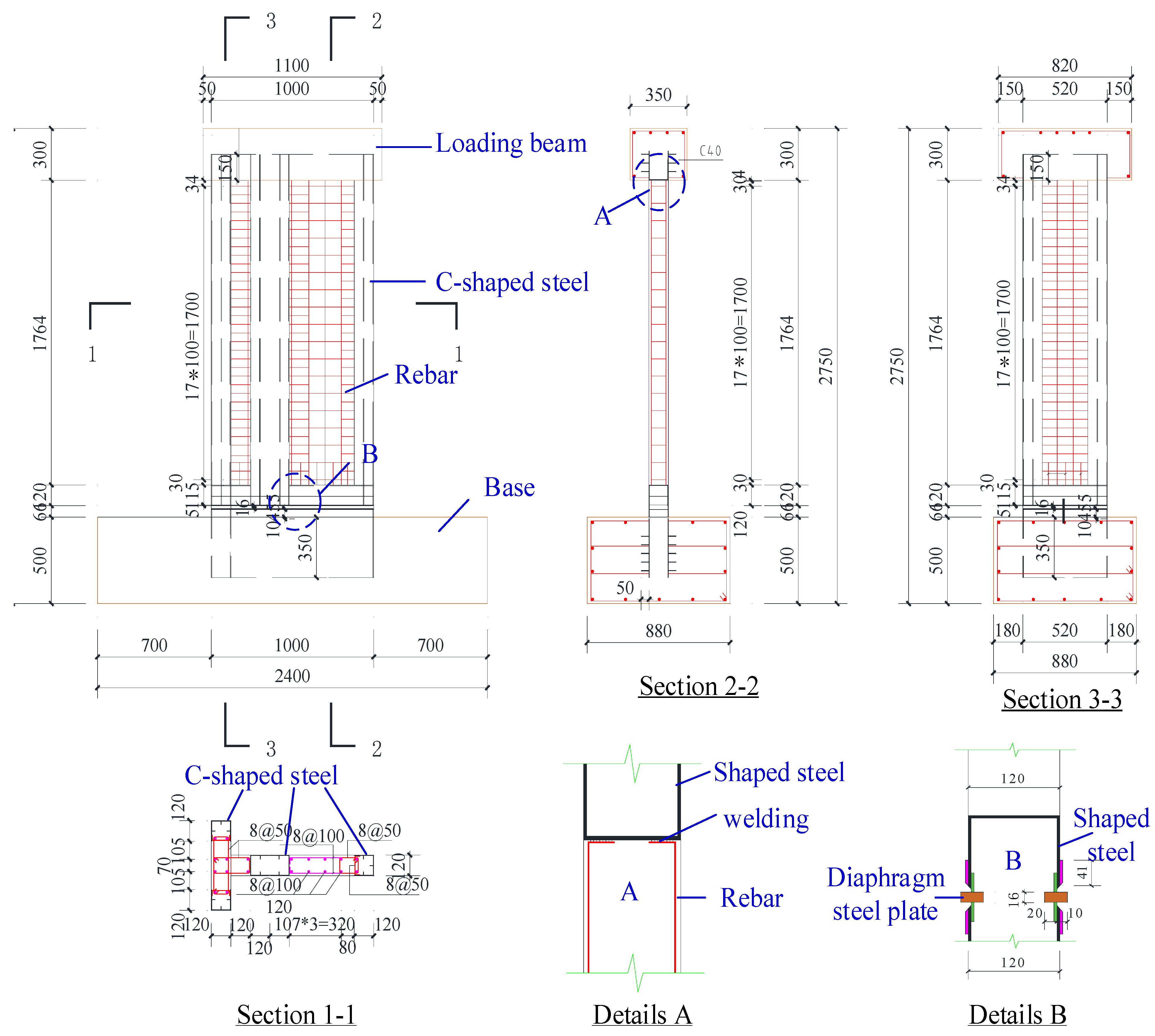

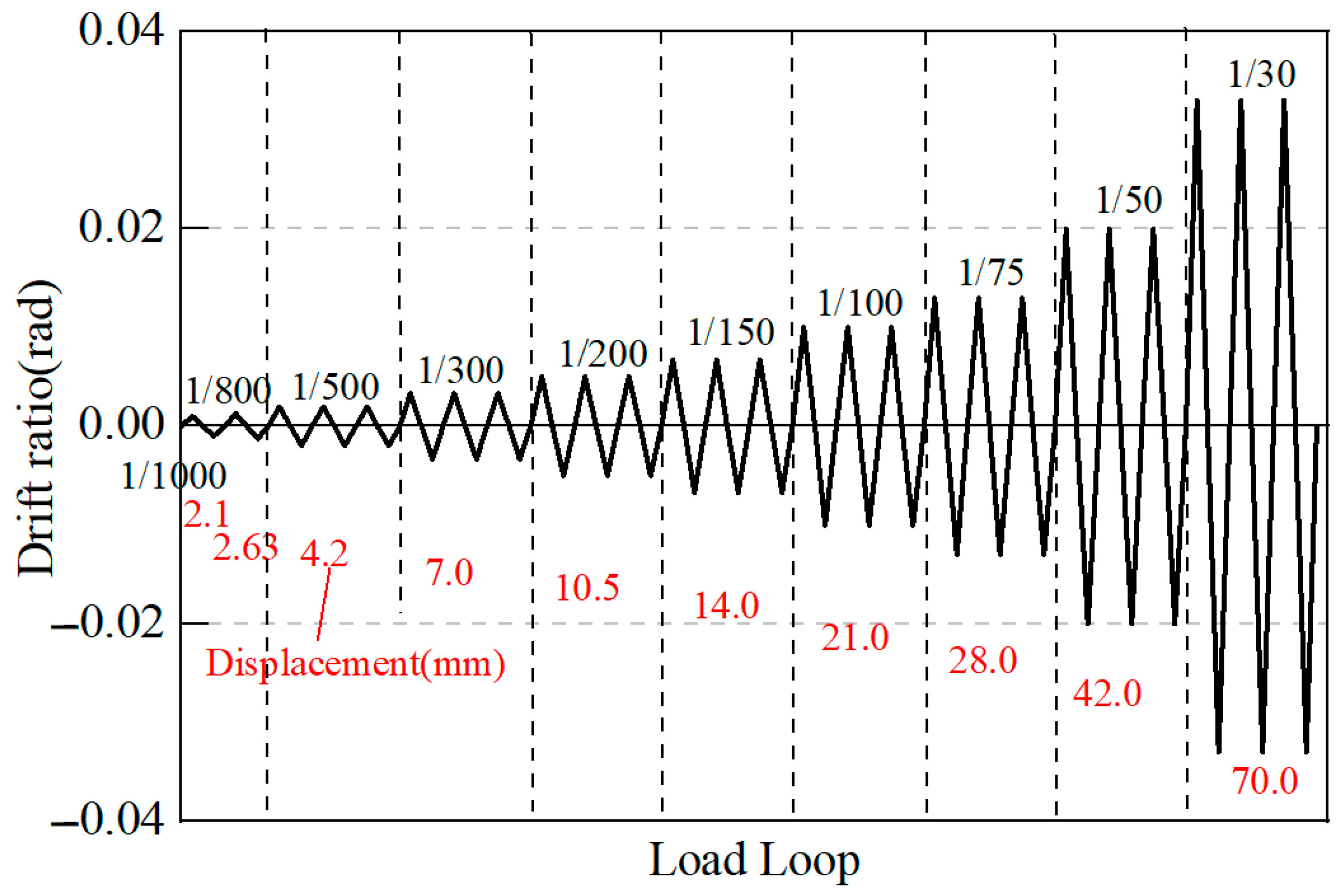
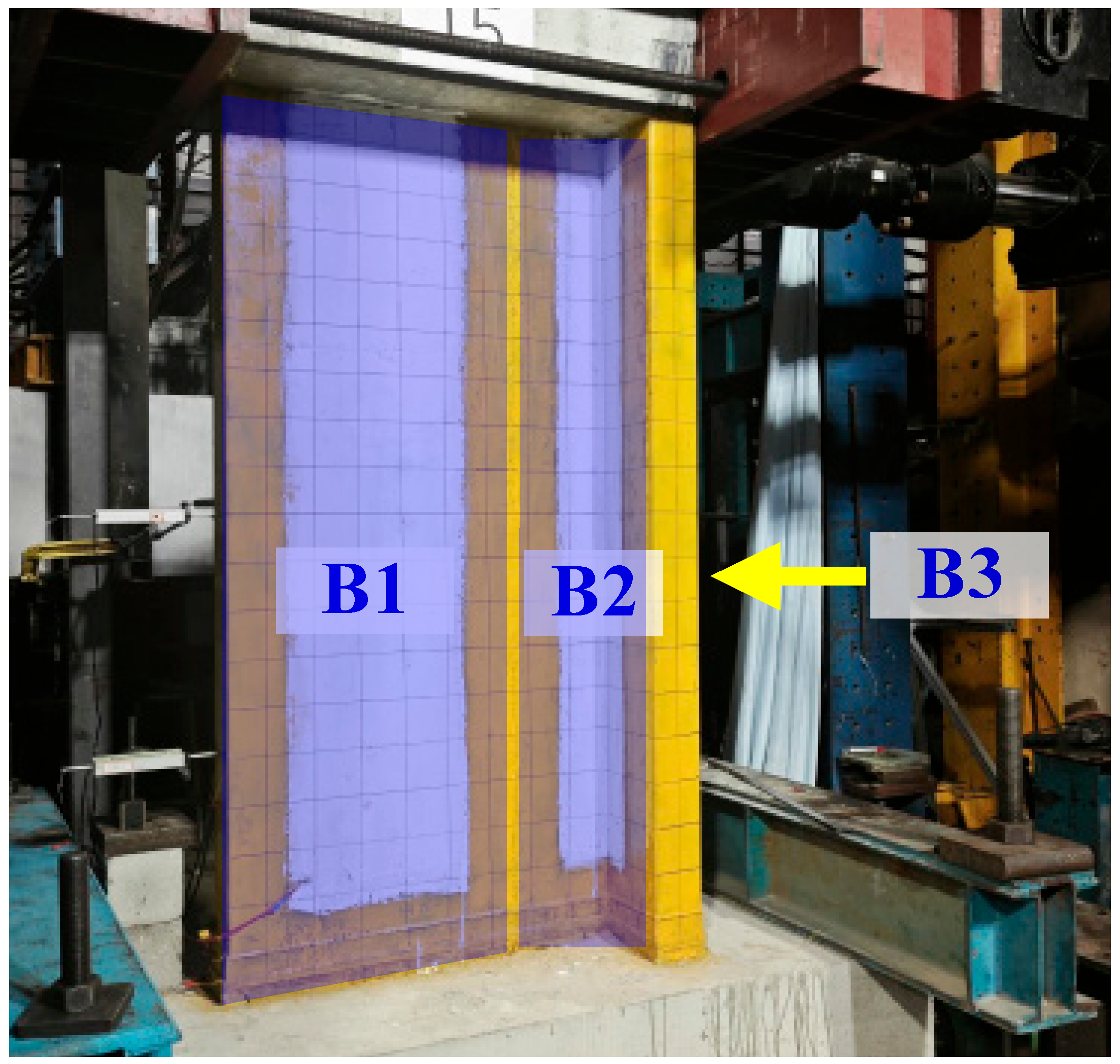

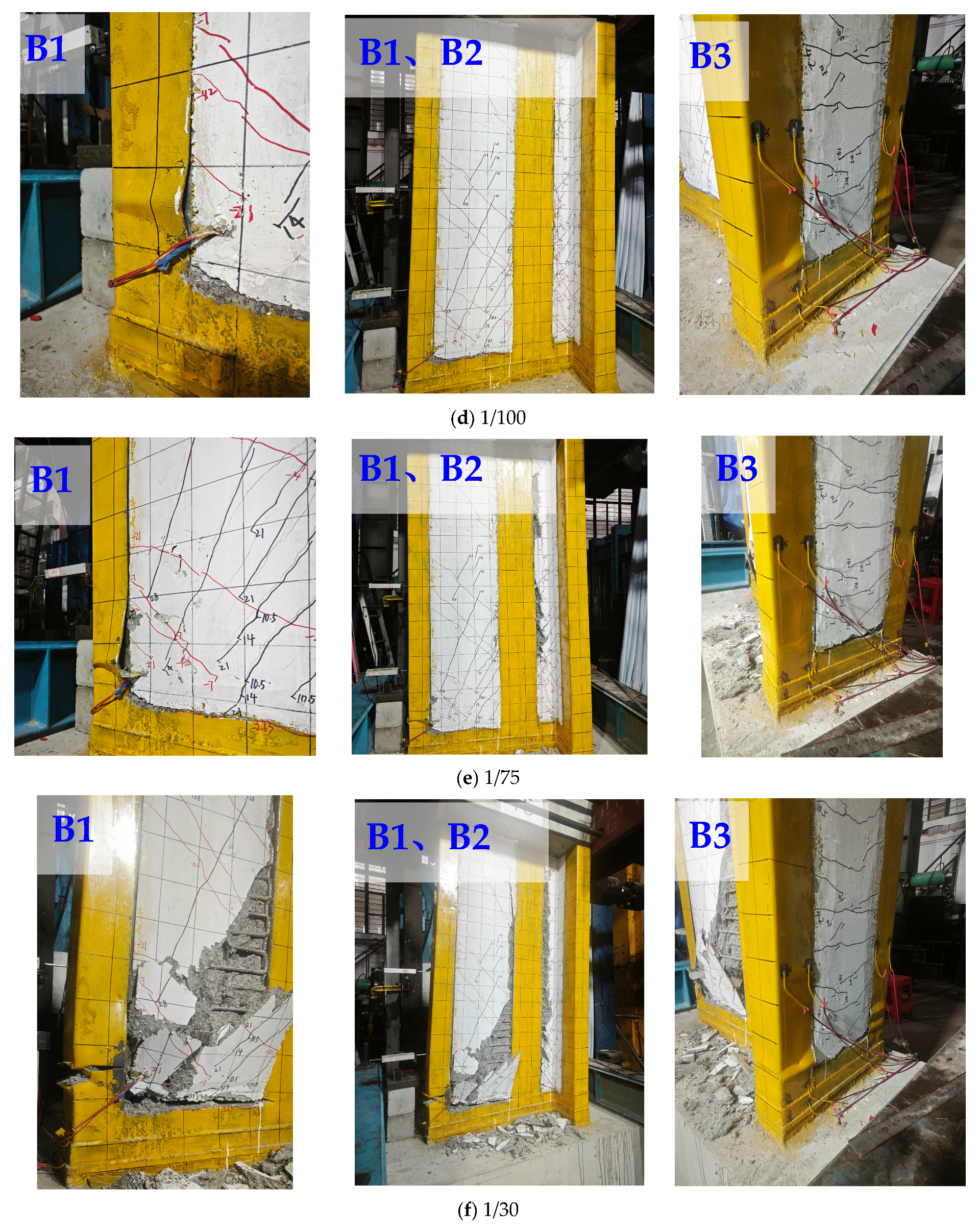
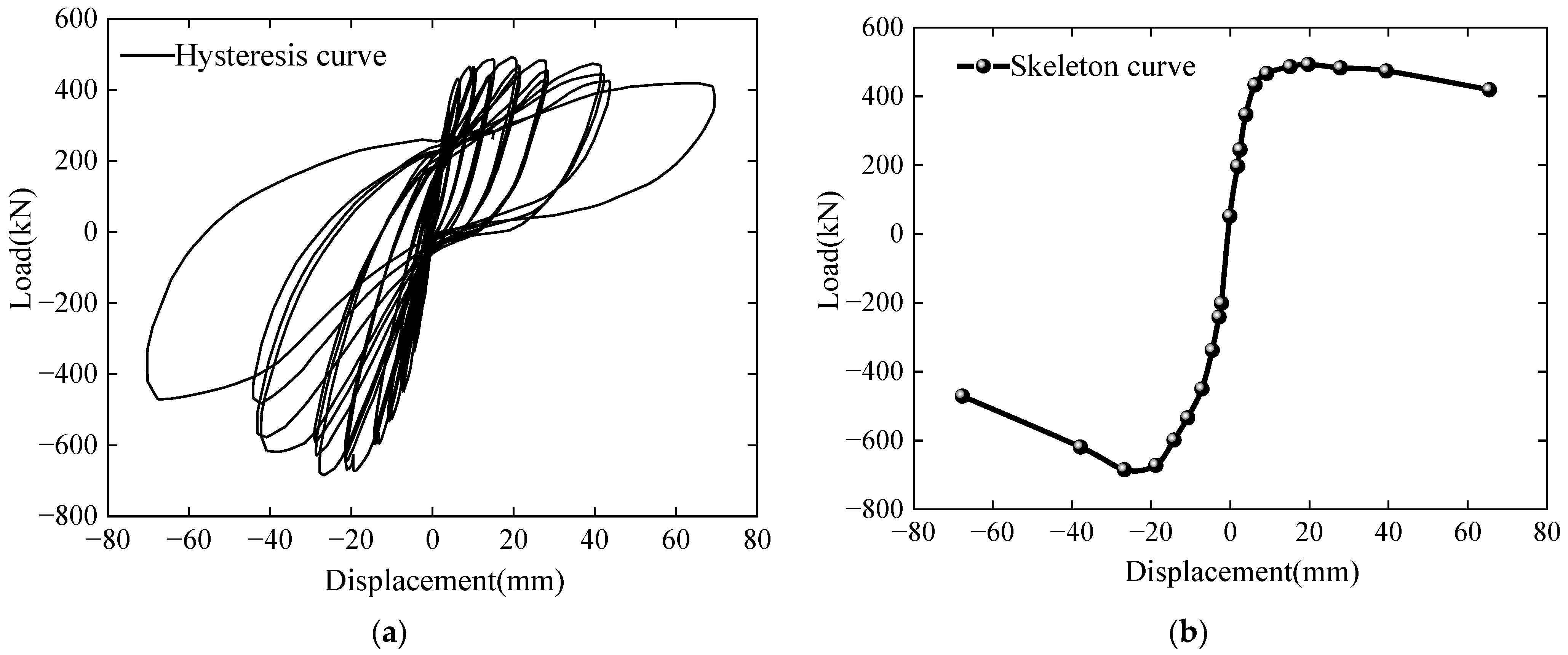

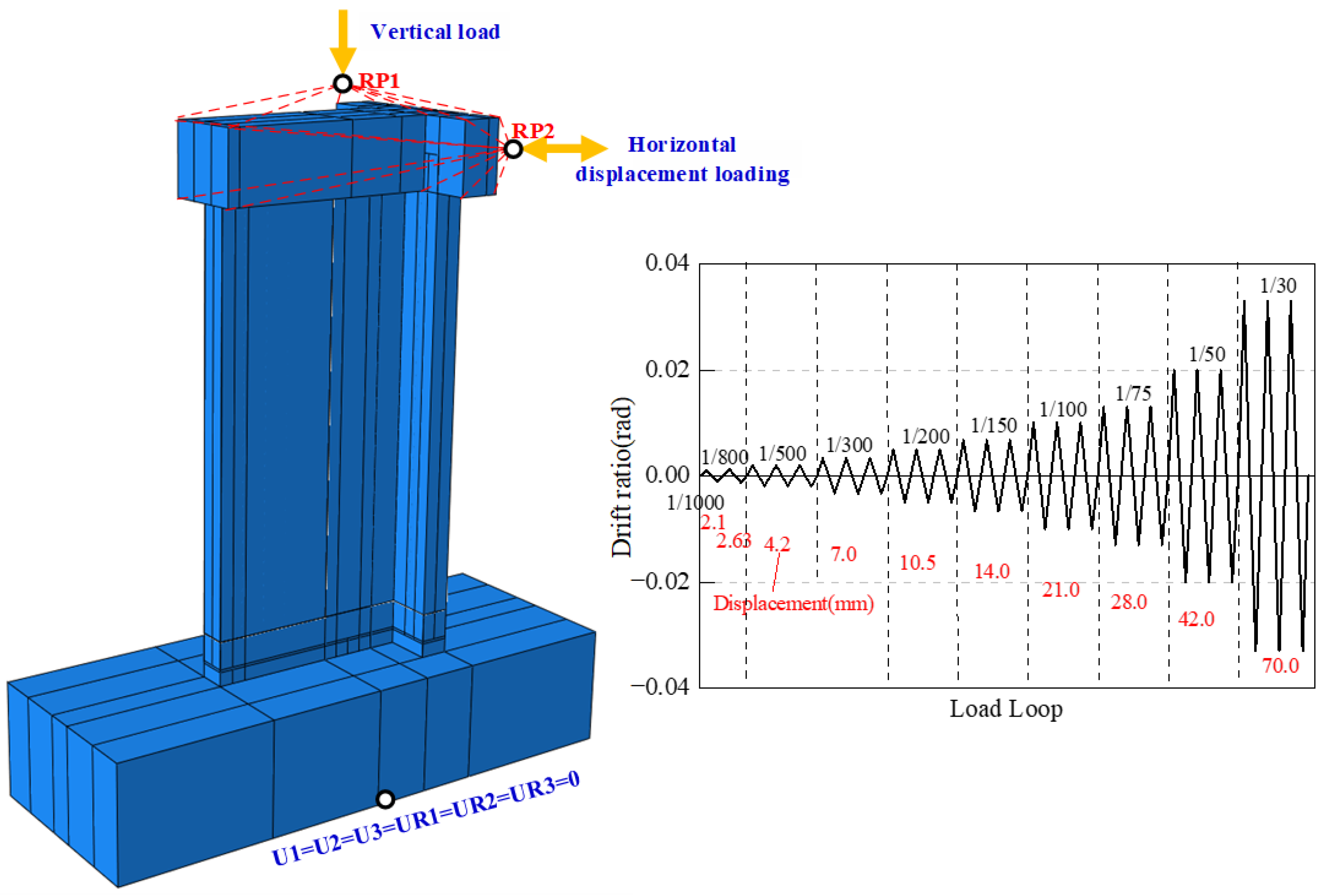
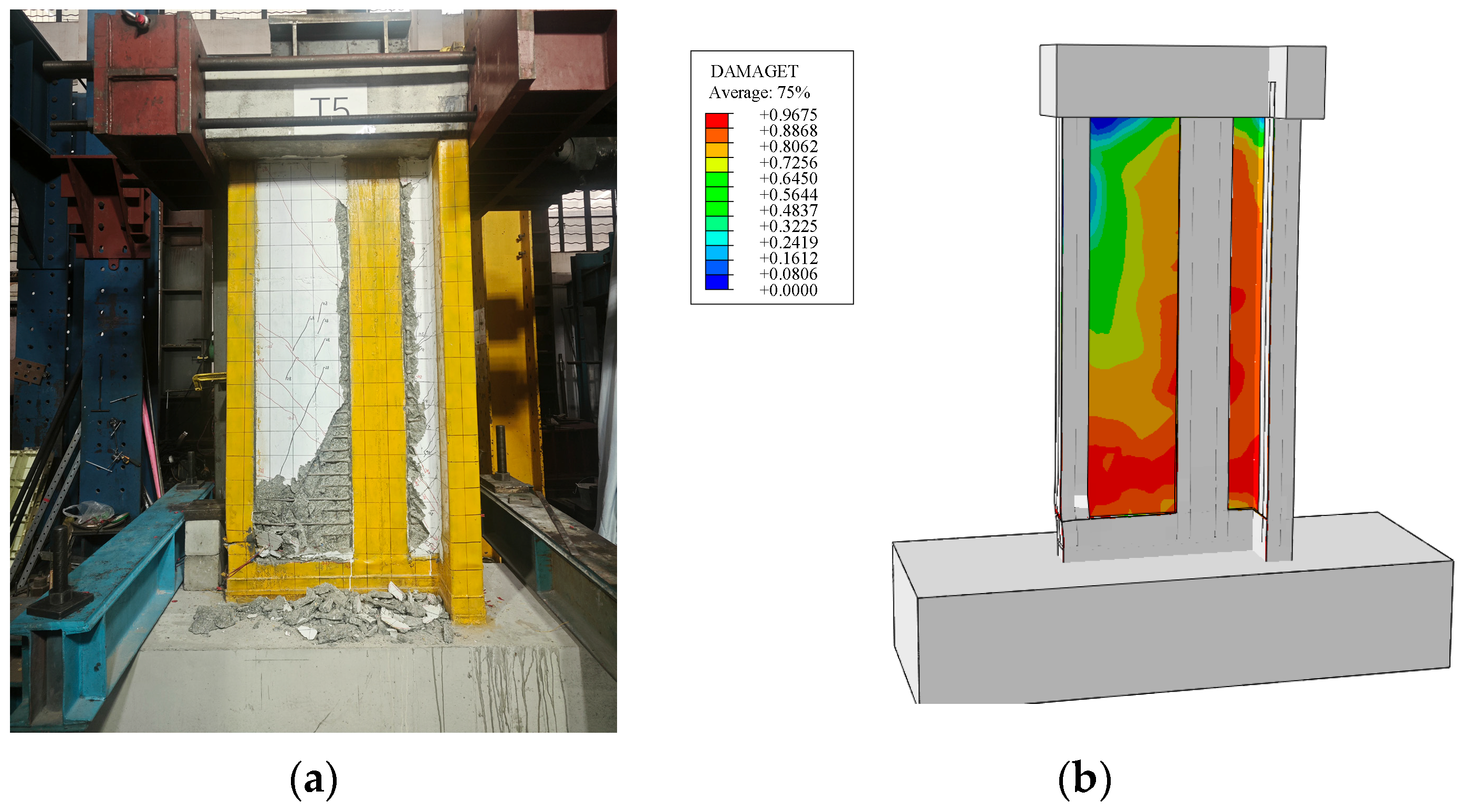
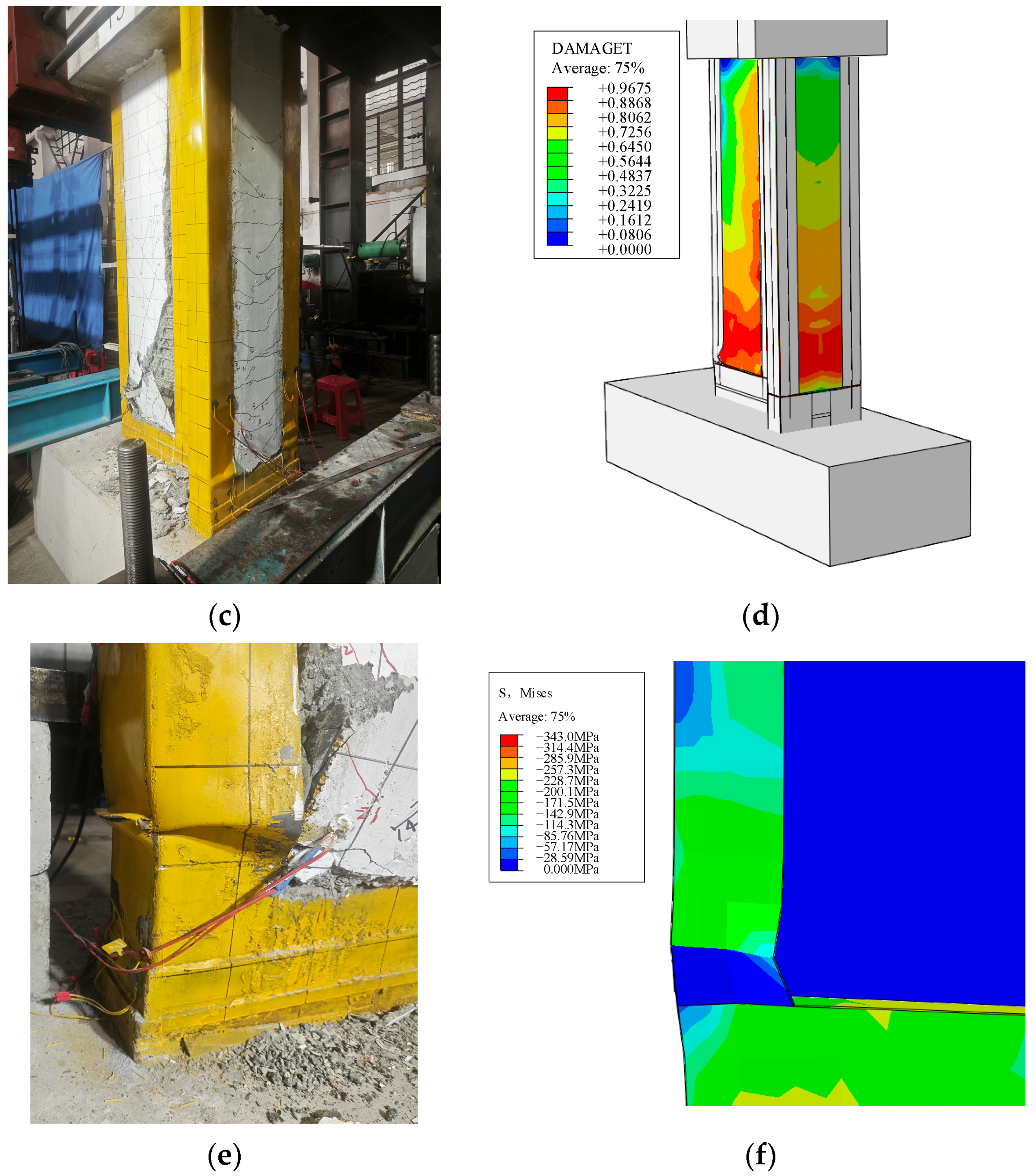


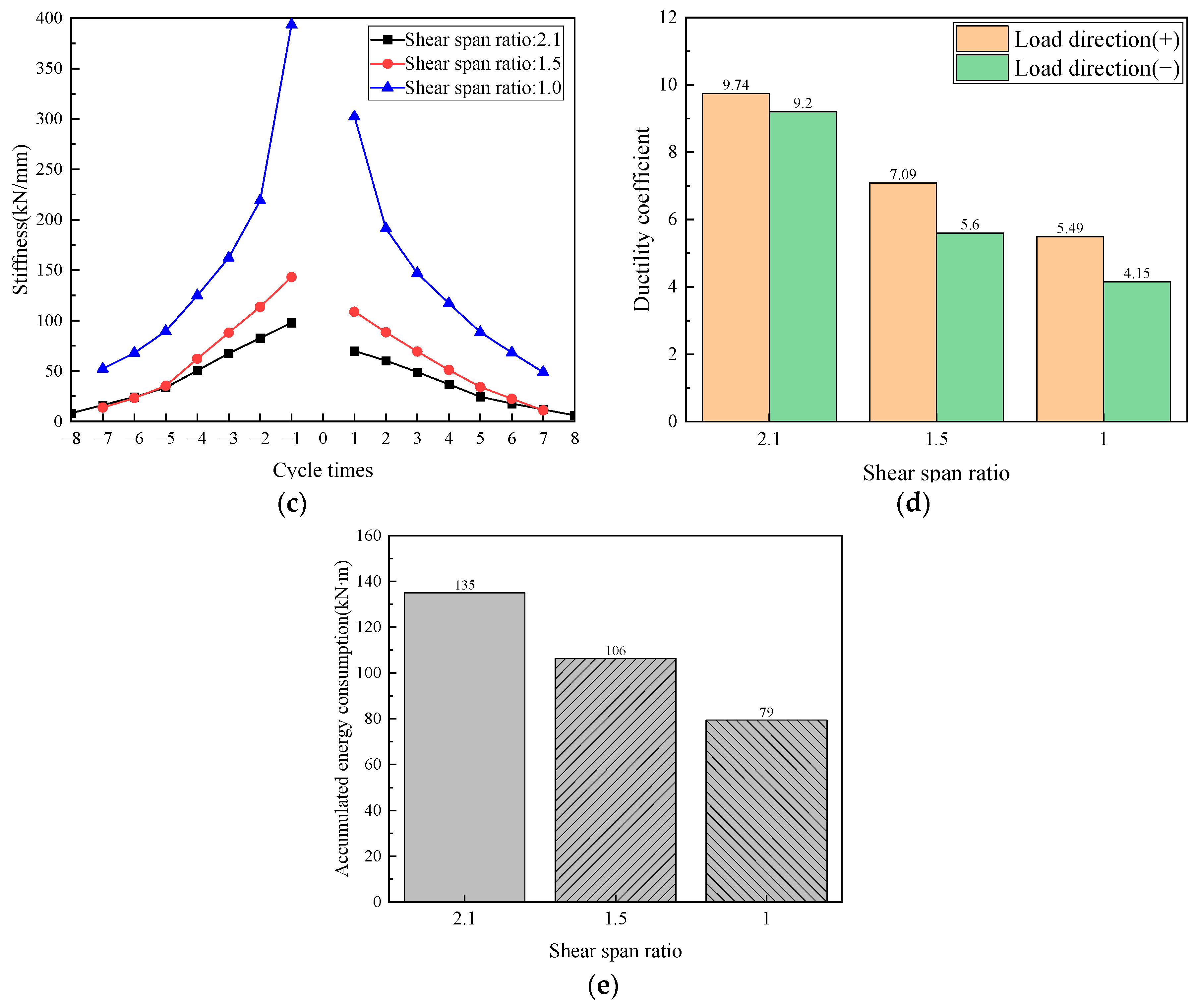
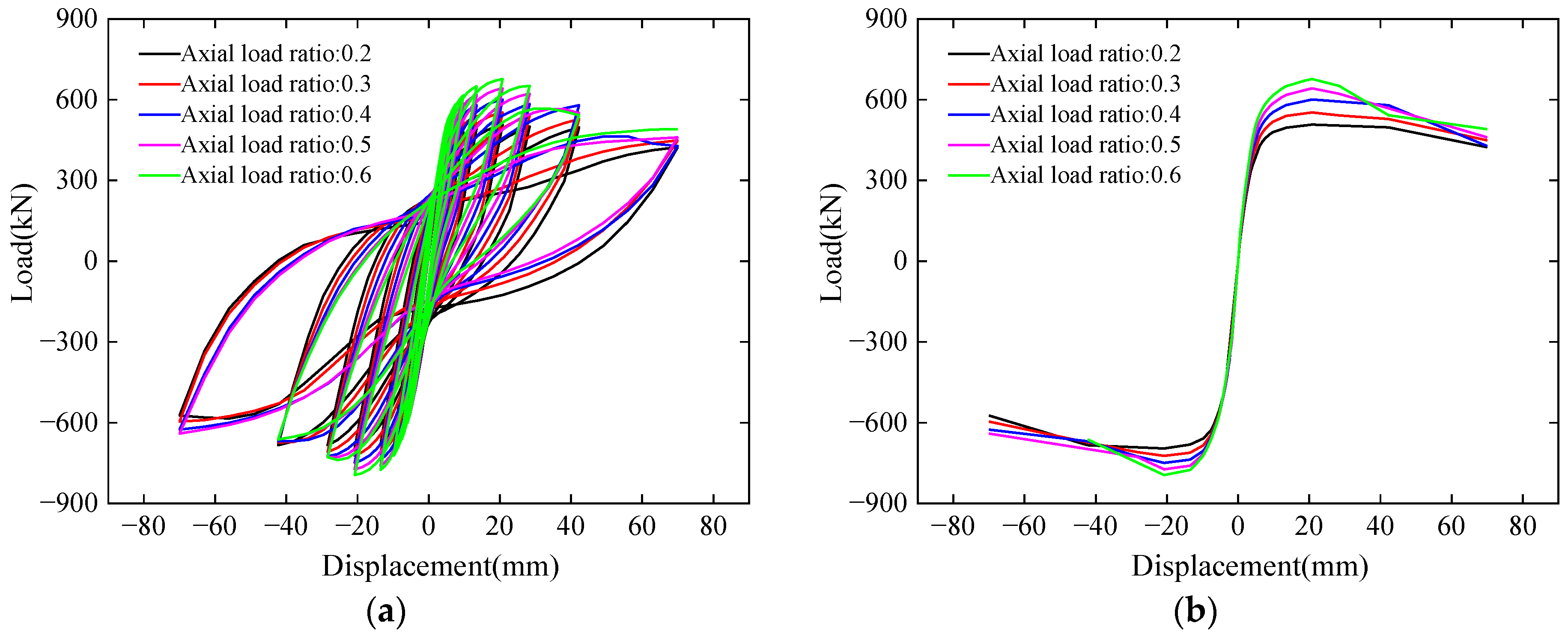
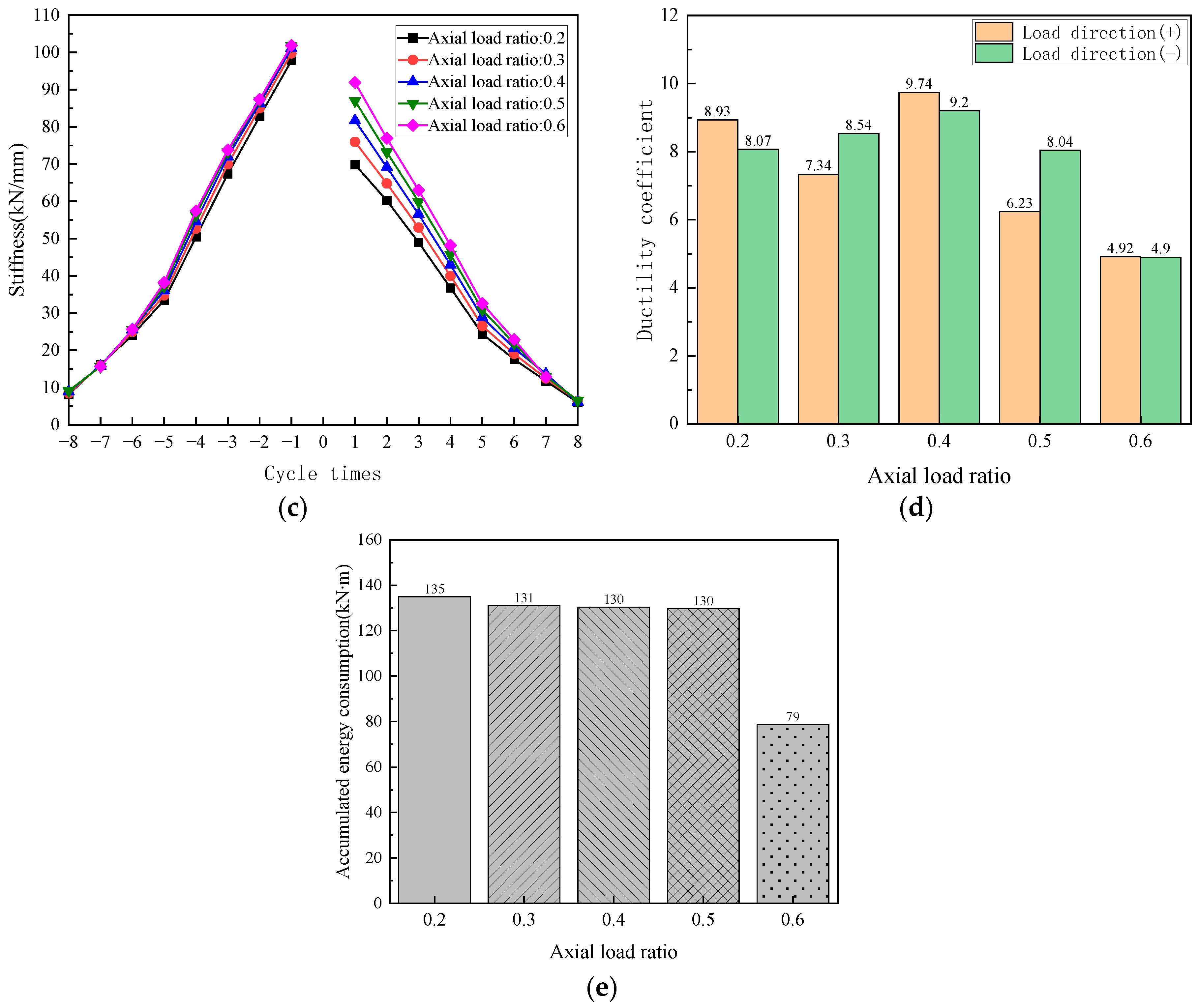
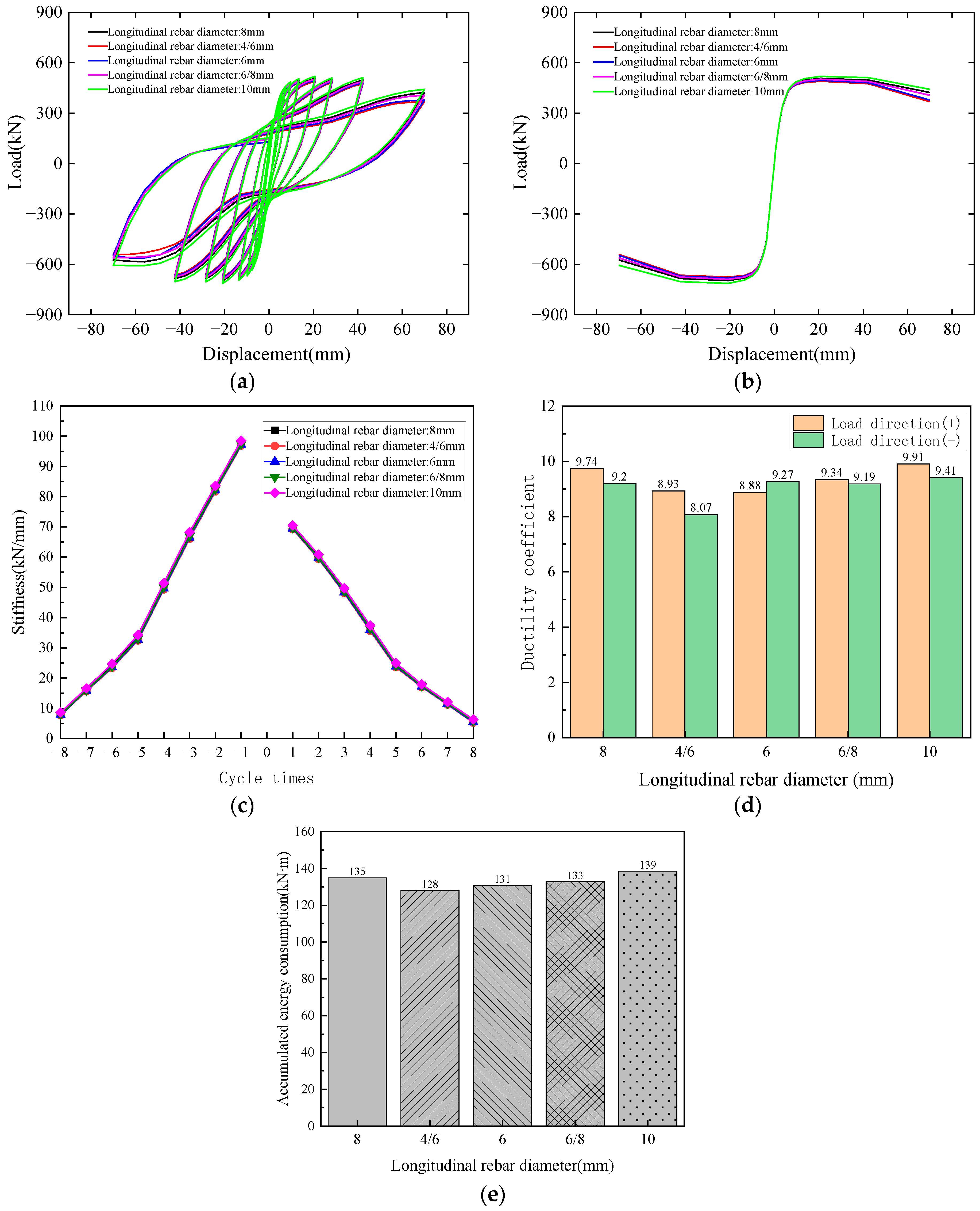

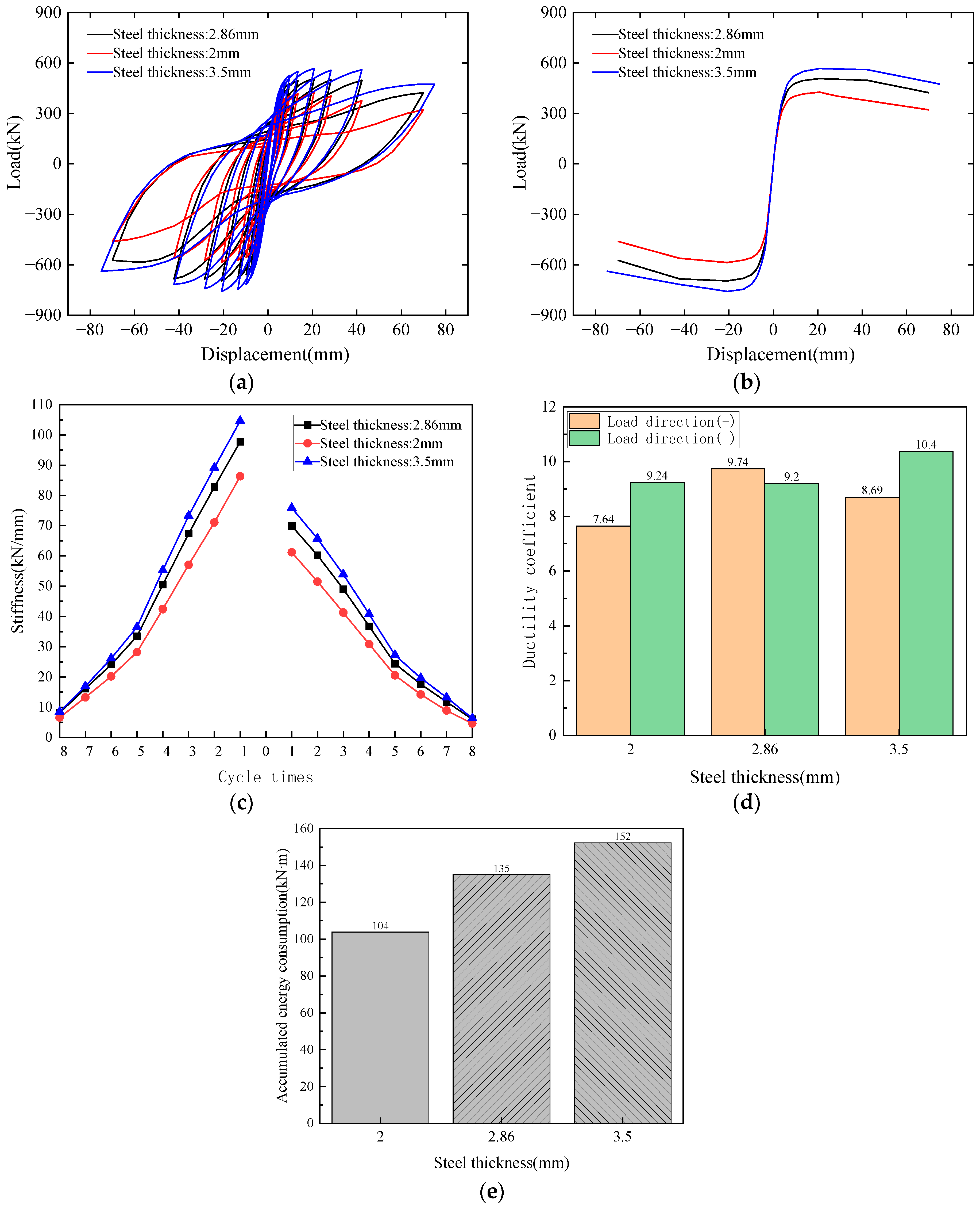
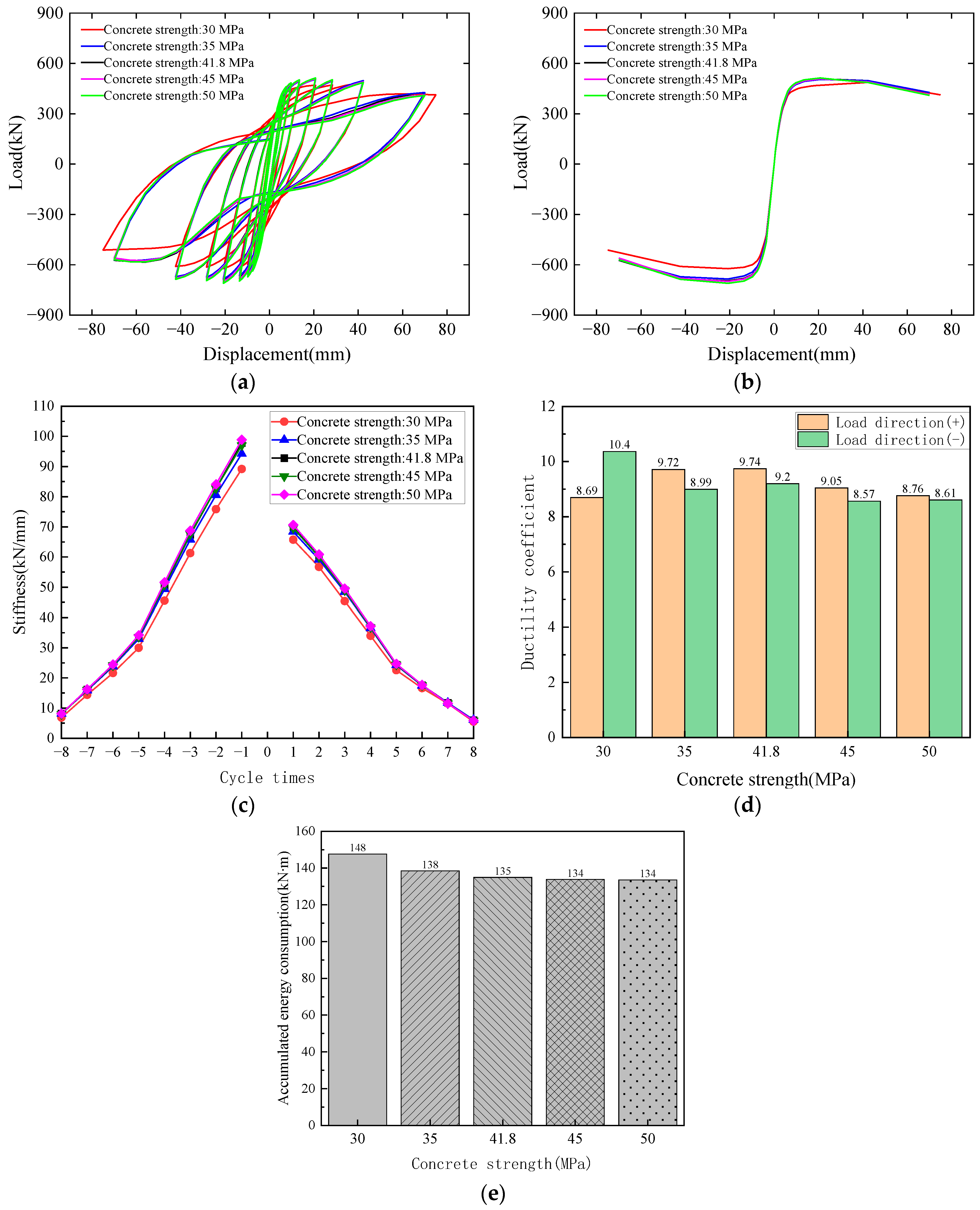
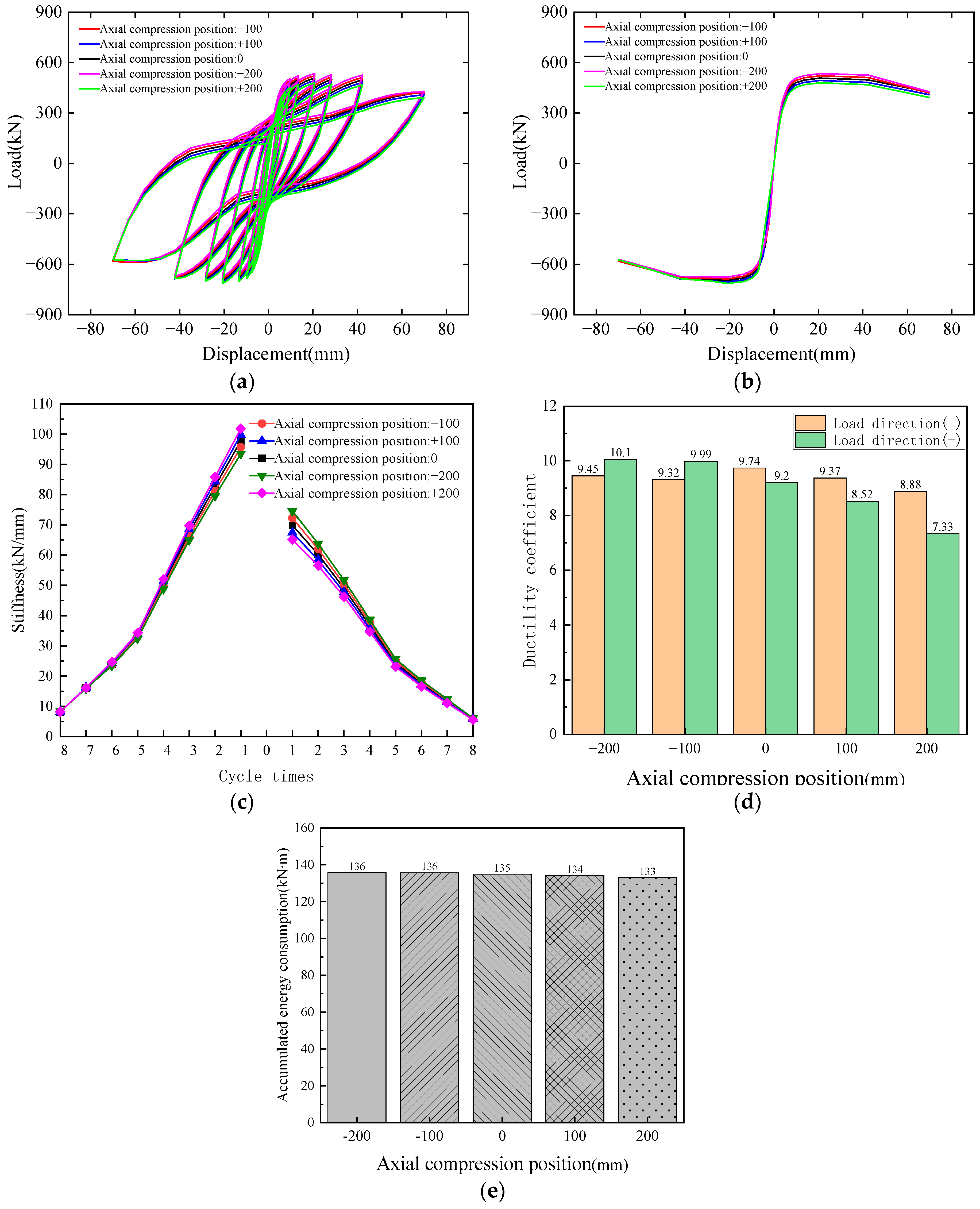
| Steel Type | Thickness or Diameter (mm) | Yield Strength (MPa) | Ultimate Strength (MPa) | Elastic Modulus (MPa) |
|---|---|---|---|---|
| Steel plate (Q235) | 2.86 | 279 | 419 | 201,125 |
| Steel bar (HRB400) | 8 | 416 | 604 | 193,587 |
| Specimen | Loading Direction | Axial Load Ratio | Yield Point | Peak Point | Ductility Coefficient | Initial Stiffness (kN/mm) | ||
|---|---|---|---|---|---|---|---|---|
| Displacement (mm) | Load (kN) | Displacement (mm) | Load (kN) | |||||
| TSCCW | (+) | 0.2 | 6.78 | 438.76 | 19.7 | 492.41 | 9.65 | 77.43 |
| (−) | 7.13 | 572.22 | 26.8 | 684.6 | 9.02 | 102.1 | ||
| Verifications | Loading Direction | Yield Load | Peak Load | Initial Stiffness | |||
|---|---|---|---|---|---|---|---|
| EXP | FEM | EXP | FEM | EXP | FEM | ||
| Results | (+) | 438.76 | 445.35 | 492.41 | 507.73 | 77.43 | 69.88 |
| (−) | 572.22 | 615.44 | 684.60 | 696.17 | 102.10 | 97.76 | |
| Error:(EXP-FEM)/EXP | (+) | 0.01 | 0.03 | 0.10 | |||
| (−) | 0.08 | 0.02 | 0.04 | ||||
| Model | Parameter | ||||||
|---|---|---|---|---|---|---|---|
| Shear Span Ratio | Axial Load Ratio | Diameter of Longitudinal Rebar/mm | Stirrup Diameter/mm | Thickness of Steel/mm | Concrete Strength/MPa | Axial Compression Position/mm | |
| Original model | 2.1 | 0.2 | 8 | 8 | 2.86 | 41.8 | 0 |
| 1–2 | 1.5, 1 | 0.2 | 8 | 6 | 2.86 | 41.8 | 0 |
| 3–6 | 2.1 | 0.3, 0.4, 0.5, 0.6 | 8 | 6 | 2.86 | 41.8 | 0 |
| 7–10 | 2.1 | 0.2 | 4/6, 6, 6/8, 10 | 6 | 2.86 | 41.8 | 0 |
| 11–14 | 2.1 | 0.2 | 8 | 4/6, 6, 6/8, 10 | 2.86 | 41.8 | 0 |
| 15–16 | 2.1 | 0.2 | 8 | 6 | 2, 3.5 | 41.8 | 0 |
| 17–20 | 2.1 | 0.2 | 8 | 6 | 2.86 | 30, 35 45, 50 | 0 |
| 21–24 | 2.1 | 0.2 | 8 | 6 | 2.86 | 41.8 | −100, +100 −200, +200 |
Disclaimer/Publisher’s Note: The statements, opinions and data contained in all publications are solely those of the individual author(s) and contributor(s) and not of MDPI and/or the editor(s). MDPI and/or the editor(s) disclaim responsibility for any injury to people or property resulting from any ideas, methods, instructions or products referred to in the content. |
© 2024 by the authors. Licensee MDPI, Basel, Switzerland. This article is an open access article distributed under the terms and conditions of the Creative Commons Attribution (CC BY) license (https://creativecommons.org/licenses/by/4.0/).
Share and Cite
Mo, X.; Yuan, Z.; Jia, Y.; Lu, L.; Wei, X.; Ke, N. An Experimental and Numerical Parametric Study on a Novel T-Shaped Steel–Concrete Composite Shear Wall. Buildings 2024, 14, 2148. https://doi.org/10.3390/buildings14072148
Mo X, Yuan Z, Jia Y, Lu L, Wei X, Ke N. An Experimental and Numerical Parametric Study on a Novel T-Shaped Steel–Concrete Composite Shear Wall. Buildings. 2024; 14(7):2148. https://doi.org/10.3390/buildings14072148
Chicago/Turabian StyleMo, Xuan, Zhijun Yuan, Yigang Jia, Liangjian Lu, Xianglan Wei, and Naiwen Ke. 2024. "An Experimental and Numerical Parametric Study on a Novel T-Shaped Steel–Concrete Composite Shear Wall" Buildings 14, no. 7: 2148. https://doi.org/10.3390/buildings14072148





